A game of (half) spaces
The 2019-20 Hero Indian Super League (Hero ISL) final was played earlier this year on March 14 in an empty Fatorda Stadium due to the coronavirus in an attempt to ensure safety of the fans.

Saksham Kakkar holds an AFC A License as well as an M. Sc in Sports Coaching from the University of Worcester. He has been with the Reliance Foundation Young Champs since 2016 and also has an FA Level 2 certification.
The 2019-20 Hero Indian Super League (Hero ISL) final was played earlier this year on March 14 in an empty Fatorda Stadium due to the coronavirus in an attempt to ensure safety of the fans. While the stadium lacked fans, it wasn’t short of goals and excitement with both teams having an eye on their third Hero ISL trophy since the tournament began in 2014.
Both teams didn’t tinker with their system and kept faith with what was successful in the games leading up to the final. ATK FC (in Red) lined up in a 1-3-5-2 with Chennaiyin FC (in Blue) lining up in a 1-4-2-3-1.
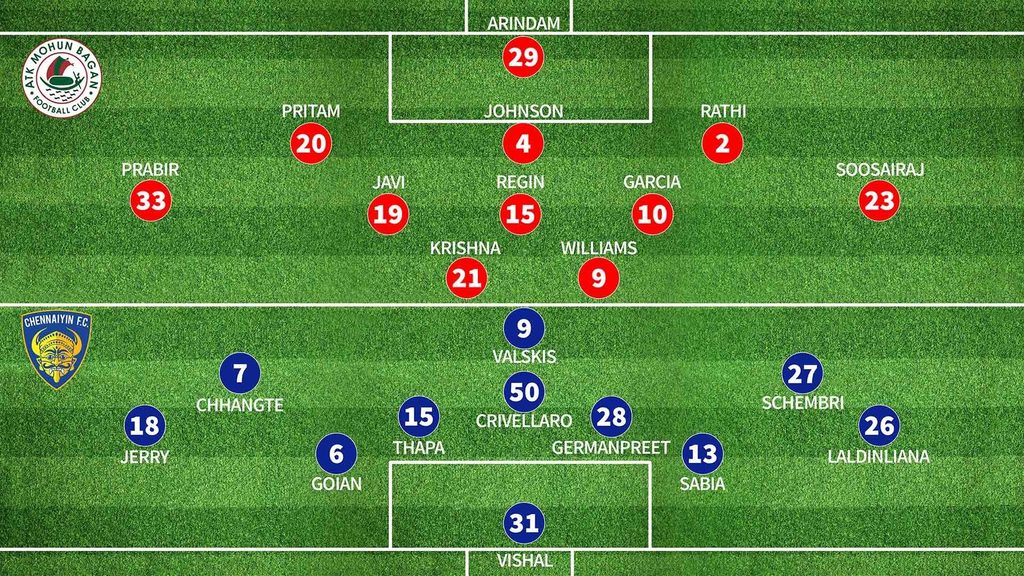
First Half
The game starts at a good pace with Rafael Crivellaro using the aerial route to good effect by lobbing over Michael Soosairaj (who played at left wingback for ATK) to first find midfielder Andre Schembri and chipping over the goalkeeper a few seconds later, only to see it cleared off the line through the head of Pritam Kotal.
Chennaiyin set the intention early on to start aggressively and threatened the space between the left wing back (Soosairaj) and the left centre back (Sumit Rathi). In the double transition moments, Soosairaj vacated a space anticipating a transition to attack and attempted to use the width of the pitch. I call it a double transition because the team can lose the ball immediately after they win the ball or vice versa and this can often create chaos & confusion in the team’s positioning.
While there was confusion in his own team during ball loss moments, Soosairaj also created spaces in the transition to attack moments for his team. The Chennaiyin right back Laldinliana Renthlei often chose to press Soosairaj and this created a space between Chennai’s right back and the right centre back Eli Sabia, which ATK exploited through diagonal runs between the two centre backs.
This space is then exploited by Roy Krishna before providing the assist for ATK’s first goal. The long diagonal pass is played by John Johnson, who has aimed it towards the corner flag. Krishna, who starts his run before the defender, has an advantage over his immediate opponent because of his speed. He faces Eli Sabia in a 1v1 before playing a backward cross into Javier Hernandez who volleys home his first goal of the season.
Both moves can be explained by the principle of dynamic superiority. Dynamic Superiority is when a player has an advantage because he is able to arrive to the ball as opposed to being static. The superiority includes other facets as such good spatial awareness and early anticipation of the next action - both important features to dominate your opponents.
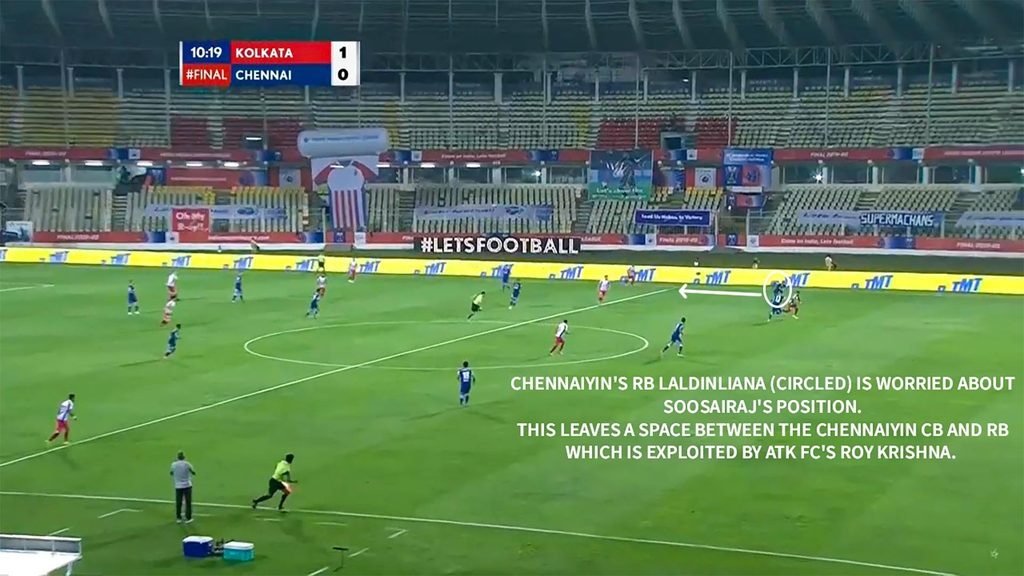
ATK had three common routes of progression into the attacking third, with the most common being a long ball into the space behind the Laldinliana. The other two came from throw ins, free kicks or transition to attacks. Their idea never changed: look to progress forward quickly through a direct route (mostly long ball) into the two strikers, David Williams and Krishna.
Meanwhile, Chennaiyin chose to progress differently - by constructing their game at the back, circulating and shifting the ATK defenders to find openings through them. ATK’s setup of 5-3-2 in a low block meant it was difficult for Chennai to penetrate through centrally. Instead, they had to rely on finding a way around them. This is where the half spaces were crucial because Schembri and winger Lallianzuala Chhangte often occupied the inverted winger roles when Chennai were in possessive.
This is effective as it allows the attackers to create superiority behind the wingback incase he commits (in this case, Soosairaj). It also allows the team in possession to reduce opposition cover by occupying the left and right centre-backs, leaving their central striker 1v1, in this case Nerijus Valskis vs Johnson.
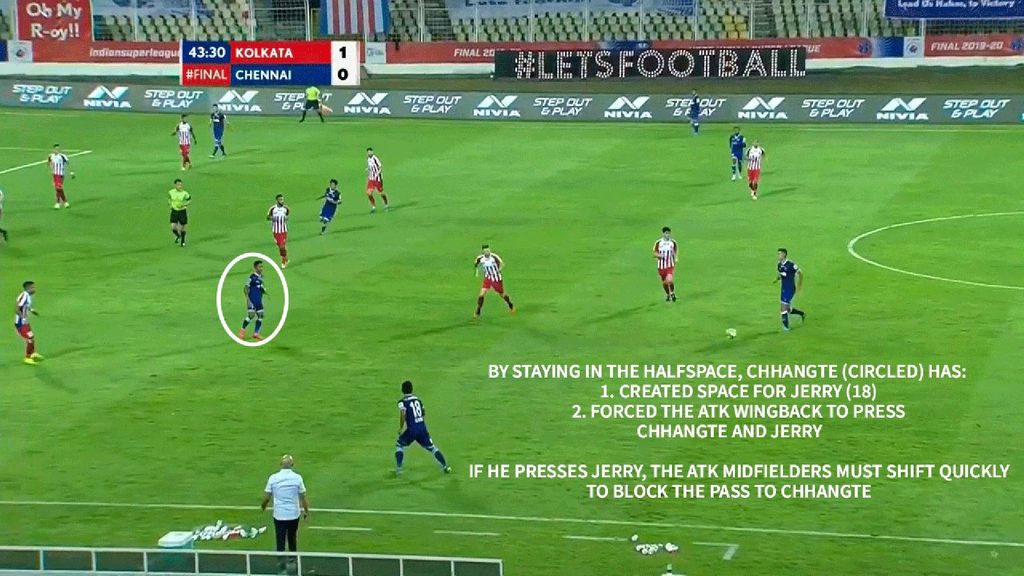
Chennaiyin’s inverted wingers also forced the ATK wingbacks to make a decision about following the man or staying in the zone. Right wingback Prabir Das often followed Chhangte inside to allow the Chennai leftback Jerry lalrinzuala enough space to occupy threatening positions to cross.
Infact, this is an old concept in football and definitely one that Coyle has seen before during his time in England. Football journalist Neil Meldrum explained in conversation with The Athletic, a similar approach taken by an English club. ‘Part of the Bournemouth way’ was stretching the opposition to a breaking point, particularly on the flanks, where former Bournemouth manager Eddie Howe’s wingers would often go narrow, allowing the fullbacks to overlap and his strikers to have complete fluidity across the width of the pitch.’ Fair to say Coyle has brought his own version of the ‘Bournemouth way’ to the Hero ISL.
The blues were dominant from the start and very unlucky to go into the break a goal down. Valskis (first half xG - 0.54) would probably have scored if it wasn’t for an in-form Arindam Bhattacharya between the sticks for ATK.
Second half
ATK’s second goal in the 48th minute is thanks to individual mistakes from Chennaiyin’s back four as well as good attacking move from Williams and Spanish forward Edu Garcia. Sabia lets the Aussie attacker shrug him off fairly easily while Laldinliana, slow in his recovery run, allows Garcia to run goal side. The left side of Chennaiyin’s defence was equally calamitous where Goian commits to the tackle instead of delaying to negate ATK’s numerical superiority while Jerry fails to recognise the offside trap.
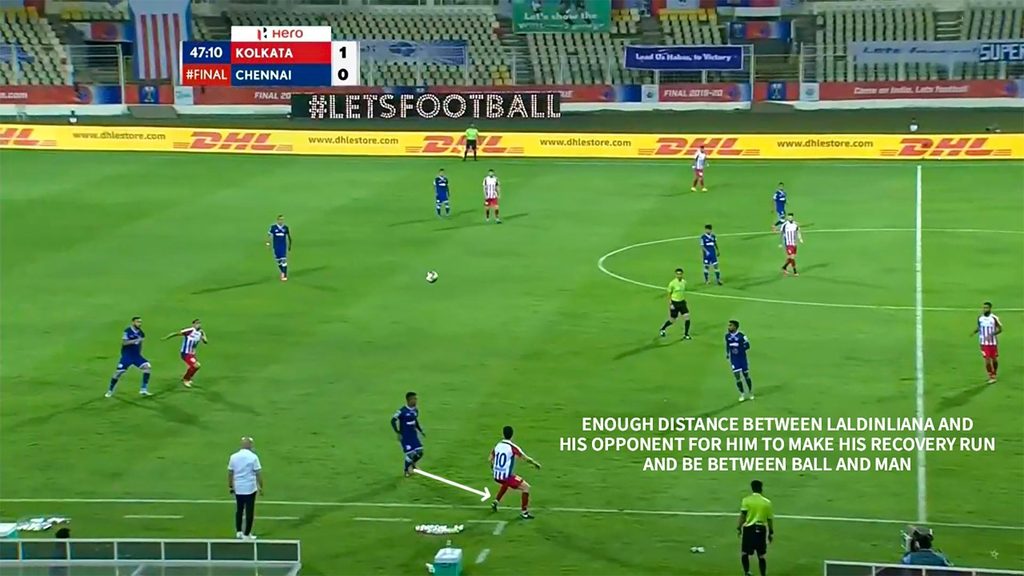
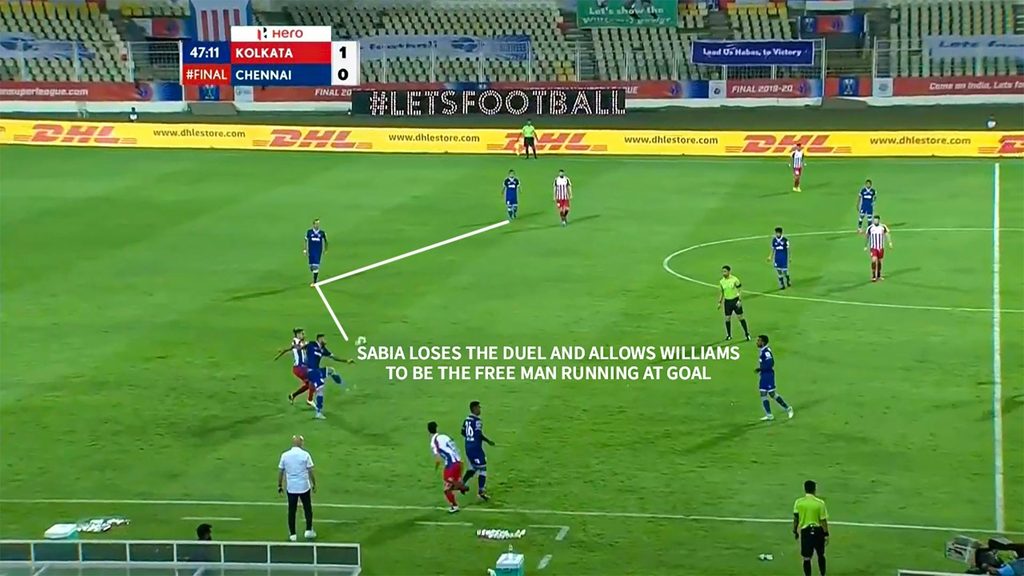
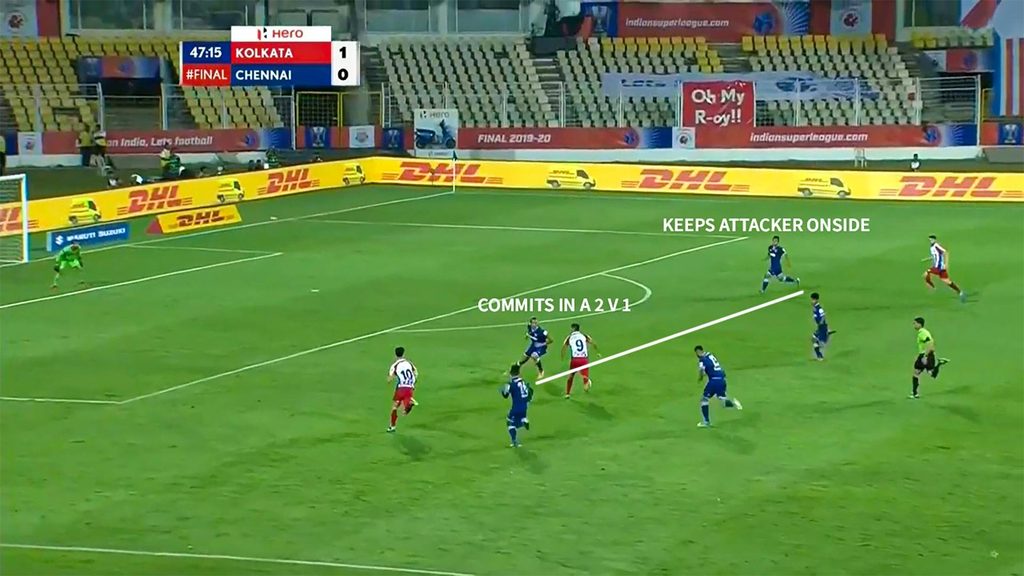
Chennaiyin started to play their best football and pin ATK back after conceding the second goal. They played with a real swagger, circulating the ball around and trying to penetrate behind ATK’s midfield line. Crivellaro was more active and Chennaiyin often tried to find him behind lines of pressure in the hope of creating something through their most creative player.
When a route through the middle was blocked, Chennaiyin advanced their fullbacks deep into the opponents’ half and started to look like 1-2-1-4-3 in possession. To get that extra edge and find a route around the ATK line of 5, Chennaiyin needed something different like opposite movements or overloading the centre of the pitch (through the wide fullbacks or one of the centre backs) to outnumber the three ATK midfielders.
The Marina Machans started to build momentum in search of a goal by stretching the field of play in possession. They did this either vertically by using the back pass to invite the opponents to press or by circulating the ball across the width of the pitch forcing ATK to shift horizontally. The latter is where Chennaiyin’s goal comes from in the 68th minute.
A one-two between Laldinliana and Anirudh Thapa sees the former with space on the right side before playing a deep cross into the penalty box which was initially headed clear by Kotal and picked up by Jerry, who sets up Valskis to score.
Crucial to Chennaiyin’s plan was to build up from every possible open play opportunity allowing them to set their structure and progress up the pitch. Only thrice did Goalkeeper Vishal Kaith choose to go long from goal kicks. After conceding, ATK dropped even deeper allowing Chennai to have possession in more advanced areas.
Chennaiyin continued to play packing (retaining possession whilst eliminating opponents) passes from the back but only ended up partially eliminating one rival in Williams without being able to progress forwards. Instead, if Chennaiyin could have completely eliminated Williams by fixing him through a dribble, it would have allowed them more continuity and progression by targeting the next line. If Chennaiyin could go one step further and play a 1v1 at the back, it would allow one extra defender to step into the middle of the pitch to overload ATK’s midfield.
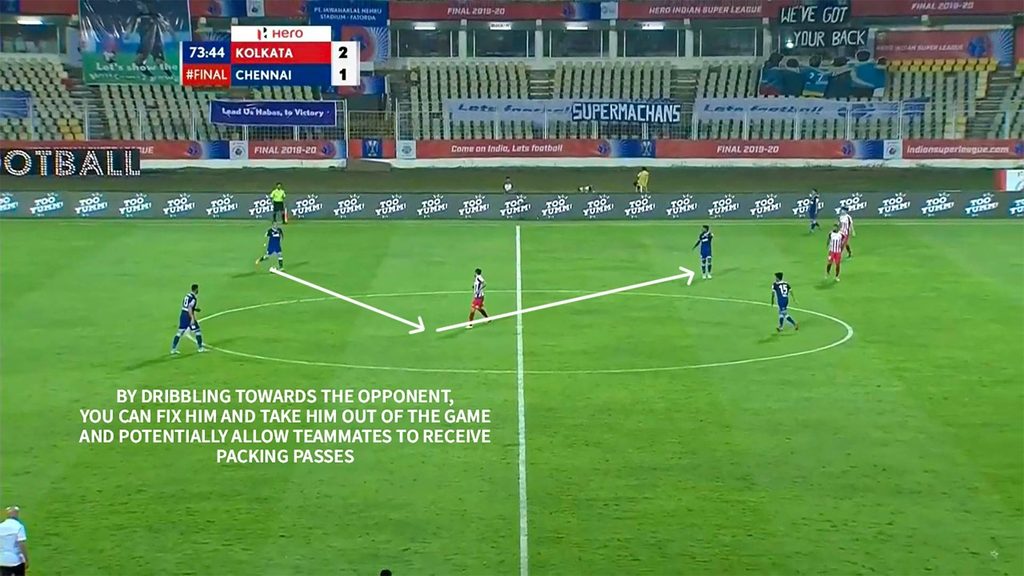
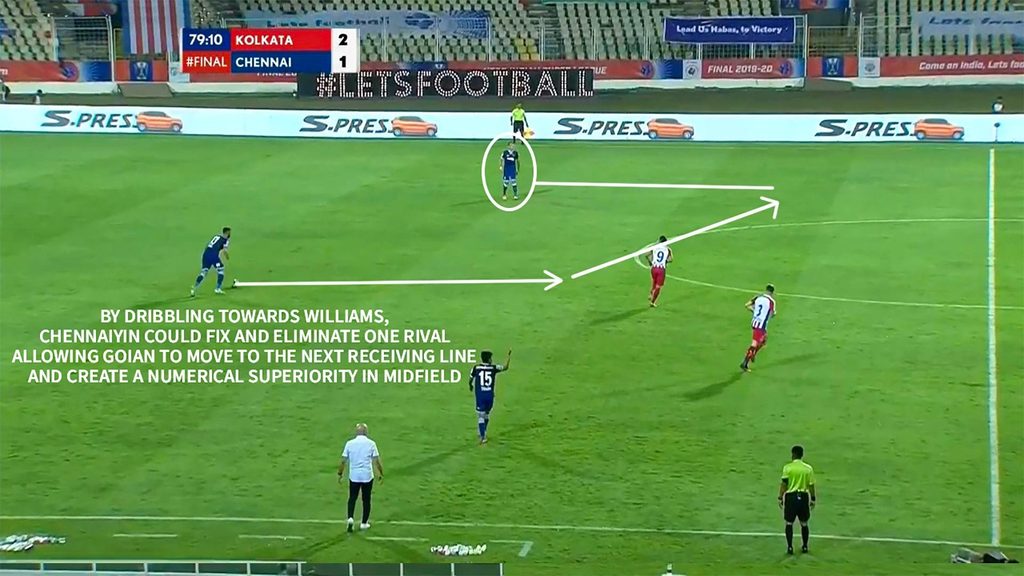
After Pranoy Halder’s introduction, ATK resorted to a line of 4 in midfield with Garcia stepping in to have a numerical superiority which made it difficult for Chennaiyin to progress through the lines. The odd time when they did break the midfield line, Crivellaro chose to shoot from distance to his manager’s displeasure. The other times, they resorted to crosses from wide areas, and although it worked for the goal, the cross had to be extremely precise to earn its reward because of the numerical inferiority within the box.
The last minutes of the game more or less played out the same until Vishal Kaith recovered the ball and in a moment of panic, decided to thump it long in search of an equaliser. This action led to a turn in momentum, with ATK scoring less than a minute later and Hernandez grabbing his second of the game.
Kaith’s decision and its consequence reminds us of what Manchester City manager Pep Guardiola said, “When you’re in search for an equaliser, the temptation is to get the ball to them as quickly as we can. But what is really needed in these moments is the midfielders mentality of ‘win the ball and move the ball around 50 times’. What this does is lower the heat of the match while the opponent loses heat and energy. Now you can work a way out to play and score against them. But if you take the ball and bomb forward, you’ll lose it and run more to chase it back. The rivals will be able to catch you again. That is not the way, win the ball and pass it twenty times. This is the way”.
Kaith’s decision to kick the ball long might have been effective if there was a clear intention and the team had a superiority in the area that he launched the ball into. Shortly after, the final whistle blew and ATK were crowned champions of the ISL.
Chennaiyin FC can be very proud of their performance because they chose to stick to the style that got them this far because the easier thing would have been to abandon it after going two goals down. The style paid dividends, though, because they had a higher xG compared to their opponents (1.77 compared to 1.35). Chennai even led the shots column with eight on target compared to ATK’s six.
Unfortunately, stats don’t win you matches and ATK are the best example of that. To defend for long periods require high focus and commitment levels which ATK Mohun Bagan FC head coach Antonio Lopez Habas is known for extracting from his players. Habas also won the tactical battle along with ATK’s third Hero ISL championship making him the first coach to win the title twice.
The stand out players in this game were ATK’s Sumit Rathi, who was composed and sound at the back with little room for error, and Chennaiyin’s Anirudh Thapa, who played with a real guile and seemed to have no panic in tight spaces. Both players caught the attention with their display and the future looks bright for them and Indian football if they can continue to challenge themselves every day.
You can watch the highlights of the game here.
You can view the match-centre here.

























